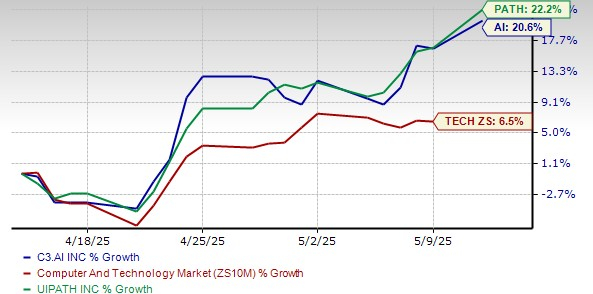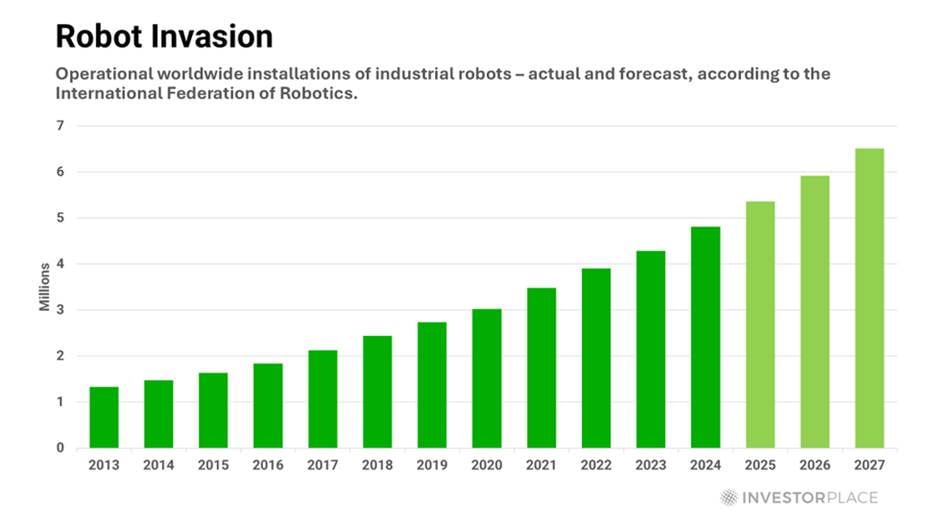“`html
Comparing the Investment Potential of C3.ai and UiPath in AI Automation
C3.ai, Inc. and UiPath Inc. are significant players in the growing AI automation market. C3.ai focuses on enterprise AI applications, offering tools in predictive maintenance and generative AI, whereas UiPath is recognized as a leader in robotic process automation, transitioning towards “agentic AI” solutions. Both companies have gained momentum due to the surge in interest surrounding artificial intelligence. By 2025, C3.ai is characterized as smaller but rapidly growing, while UiPath is larger with a more stable financial foundation.
These firms embody two key trends—AI advancement and digital transformation—making them attractive to investors looking for long-term disruption in technology. Fluctuations in both companies’ stocks, along with changing enterprise spending behaviors and new product initiatives, have renewed the interest in evaluating their investment viability. Given the current economic uncertainty impacting tech valuations and the fluctuating AI-focused narratives, this is a strategic moment to analyze which stock holds greater promise.
Let’s closely examine the fundamentals of these two stocks to ascertain which may be the superior investment opportunity.
The Case for C3.ai Stock
C3.ai positions itself as a pure-play enterprise AI provider, delivering a wide range of configurable AI applications that aid large organizations in implementing predictive analytics, detecting anomalies, and optimizing operations. This versatility allows its platform to scale effectively across various sectors. With over 100 pre-built AI applications spanning industries such as energy, manufacturing, and financial services, C3.ai’s growth strategy hinges on partnerships with major cloud providers and governmental institutions to expedite market entry and broaden distribution.
Strengths for C3.ai include its leadership in enterprise AI applications. The company asserts its first-mover advantage in “model-driven” AI across 19 diverse industries and the U.S. federal government, reporting a 100% increase in federal revenues for fiscal 2024. Significant customers include ExxonMobil (XOM), the U.S. Navy, Shell, BASF, and various government entities. Recently, C3.ai strengthened its position with Microsoft, securing 28 new agreements through collaborative efforts across nine industries. Their partnership has notably shortened sales cycles by approximately 20%, reflecting a robust joint go-to-market initiative. As of the end of the fiscal third quarter, C3.ai engaged in over 600 active enterprise opportunities globally, indicating potential continued growth as companies increasingly seek AI solutions for efficiency.
In its fiscal third-quarter results, C3.ai’s total revenues reached $98.8 million, a 26% year-over-year increase. Subscription revenue climbed 22% to $85.7 million, comprising 87% of total revenue. The company established 66 agreements, including 50 pilot programs, representing a 72% annual increase.
Nevertheless, C3.ai encounters considerable challenges, particularly in achieving consistent profitability while facing stiff competition from both established firms and new entrants. The company reported a GAAP net loss of 62 cents per share in the fiscal third quarter, with a non-GAAP loss of 12 cents per share. As growth moderation becomes evident, gross margins may decline due to a traffic of pricier pilot projects, while investments in the business could temporarily dip operating margins.
Despite substantial cash reserves totaling $724.3 million at the end of the fiscal third quarter, ongoing losses raise concerns about potential dilution or pressures on spending. The competitive landscape remains brutal, with competitors ranging from other AI startups to tech giants developing in-house solutions, potentially impacting C3.ai’s growth trajectory and pricing power. Growth rates appear to be slowing, with revenue growth decreasing from 29% in the fiscal second quarter to 26% in the fiscal third quarter.
The Case for UiPath Stock
Conversely, UiPath operates within robotic process automation, automating repetitive digital tasks to enhance productivity and reduce costs for businesses. Unlike C3.ai, which focuses on predictive analytics and machine learning, UiPath specializes in process optimization and workflow orchestration, leading to broad adoption across sectors like banking, insurance, healthcare, and public services. The company’s strengths lie in market competition and innovation. With a substantial global customer base and a strong retention rate (net retention approximately 110–115%), existing clients increasingly expand their accounts.
UiPath’s trajectory reveals significant financial strength, differentiating it from C3.ai. In fiscal 2025 (ending January 31, 2025), UiPath recorded revenues of $1.43 billion, representing a 9% year-over-year increase. For the fiscal fourth quarter (October 2024-January 2025), revenues were $424 million (up 5%). The robust subscription model resulted in an Annual Recurring Revenue (ARR) of $1.666 billion (up 14%). Notably, UiPath posted a GAAP operating profit of $34 million in the fiscal fourth quarter compared to a loss the previous year, and a non-GAAP operating income of $241 million for the full fiscal year. Free cash flow reached an impressive $328 million in fiscal 2025, leaving the company with approximately $1.7 billion in cash on its balance sheet and a $500 million share buyback program initiated in the fiscal second quarter.
However, UiPath also faces hurdles. Revenue growth has slowed to mid-single digits (10% in the fiscal second quarter, 9% in the fiscal third quarter, and 5% in the fiscal fourth quarter), as large enterprises reduce spending. Economic uncertainty, particularly within the U.S. public sector, has affected forecasts. The competitive landscape includes notable players like Microsoft (Power Automate), Automation Anywhere, and Blue Prism, as well as open-source alternatives. Although UiPath sustained operational losses on a GAAP basis (GAAP operating loss of $163 million for fiscal 2025), the company’s guidance indicates a path toward ongoing profitability.
Share Price Performance & Valuations for C3.ai and UiPath Stocks
As of 2025, UiPath (PATH) has outperformed the broader AI sector, increasing by 3% compared to a 29.7% decline for C3.ai (AI). Over the past month, UiPath gained 22.2%, while C3.ai rallied by 20.6%.
“`
Comparing C3.ai and UiPath: Valuation and EPS Trends
Price Performance

Image Source: Zacks Investment Research
Valuation Overview
C3.ai is currently trading at a forward 12-month price-to-sales (P/S) ratio of 6.7X. This is noticeably lower than its three-year median of 8.33X and the Zacks Computer and Technology sector average of 5.74X. In comparison, UiPath (PATH) has a forward earnings multiple of 4.63X, which is also below its three-year median of 6.41X. C3.ai’s stock appears relatively expensive against both the sector average and UiPath.
Both companies operate within the AI automation market. Nonetheless, UiPath’s valuation metrics indicate a more stable investment profile, as it anticipates future profitability that aligns with industry norms. C3.ai, meanwhile, shows a higher valuation premium and struggles with profitability, posing more considerable investment risk.

Image Source: Zacks Investment Research
EPS Projections for C3.ai and UiPath
Over the past 60 days, EPS estimates for UiPath have increased, while those for C3.ai have remained steady. The Zacks Consensus Estimate predicts a 4.3% rise in C3.ai’s 2025 bottom line, whereas PATH’s figures reflect a slight decline of 1.9% year-over-year.
For C3.ai Stock

Image Source: Zacks Investment Research
For UiPath Stock

Image Source: Zacks Investment Research
Conclusion
C3.ai and UiPath both stand to gain from the growing demand for AI-driven automation, yet their risk-reward profiles differ significantly. C3.ai shows higher revenue growth potential, with an expected 29.7% increase in fiscal 2025, thanks to early advantages in enterprise AI. However, it remains unprofitable and continues to burn cash. In contrast, UiPath is larger and nearly cash-flow positive, reporting profits on a non-GAAP basis. With a solid balance sheet, UiPath has also engaged in a $500 million buyback strategy.
In summary, while C3.ai’s prospects depend on its ability to maintain rapid growth and effectively scale its AI offerings, significant challenges lie ahead from competition and macroeconomic factors. On the other hand, UiPath offers a more established business model and justifiable valuation. Rated as a Zacks Rank #3 (Hold), it presents more favorable prospects for 2025. Its combination of profitability and robust cash flow makes it better positioned for resilience if growth slows down. C3.ai, rated as a Zacks Rank #4 (Sell), carries higher risks despite potential benefits from strong AI market trends.
This article originally published on Zacks Investment Research (zacks.com).
Zacks Investment Research
The views and opinions expressed herein are the views and opinions of the author and do not necessarily reflect those of Nasdaq, Inc.







